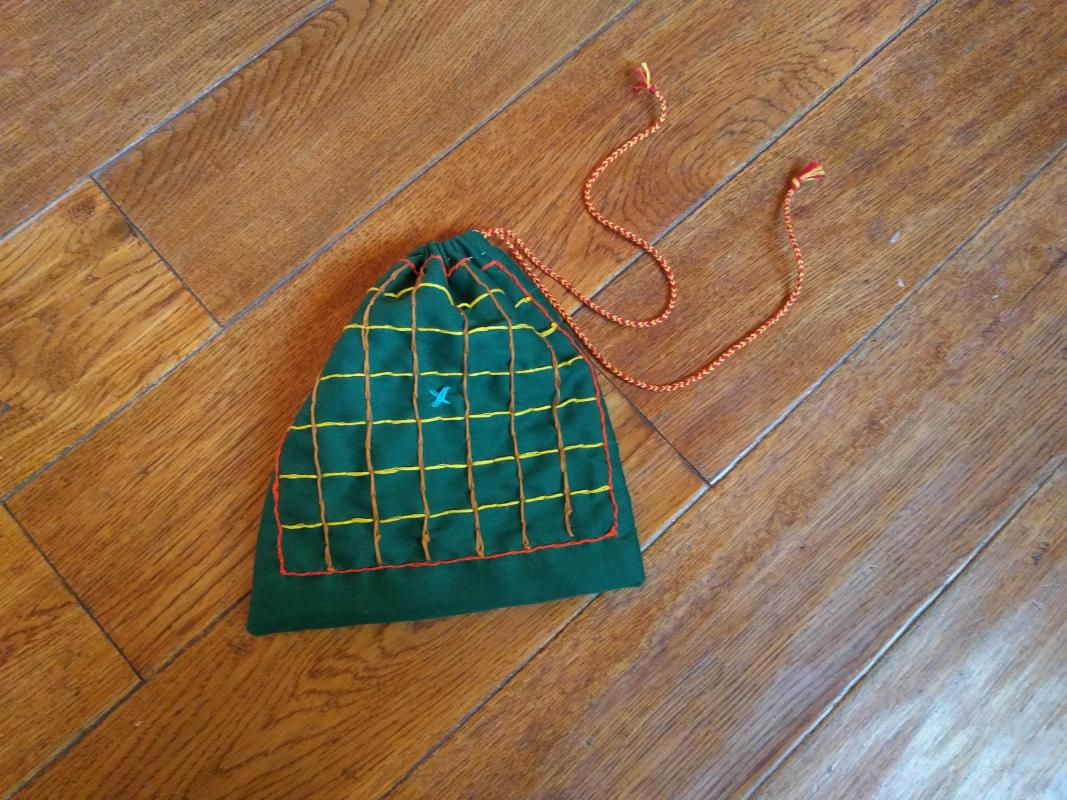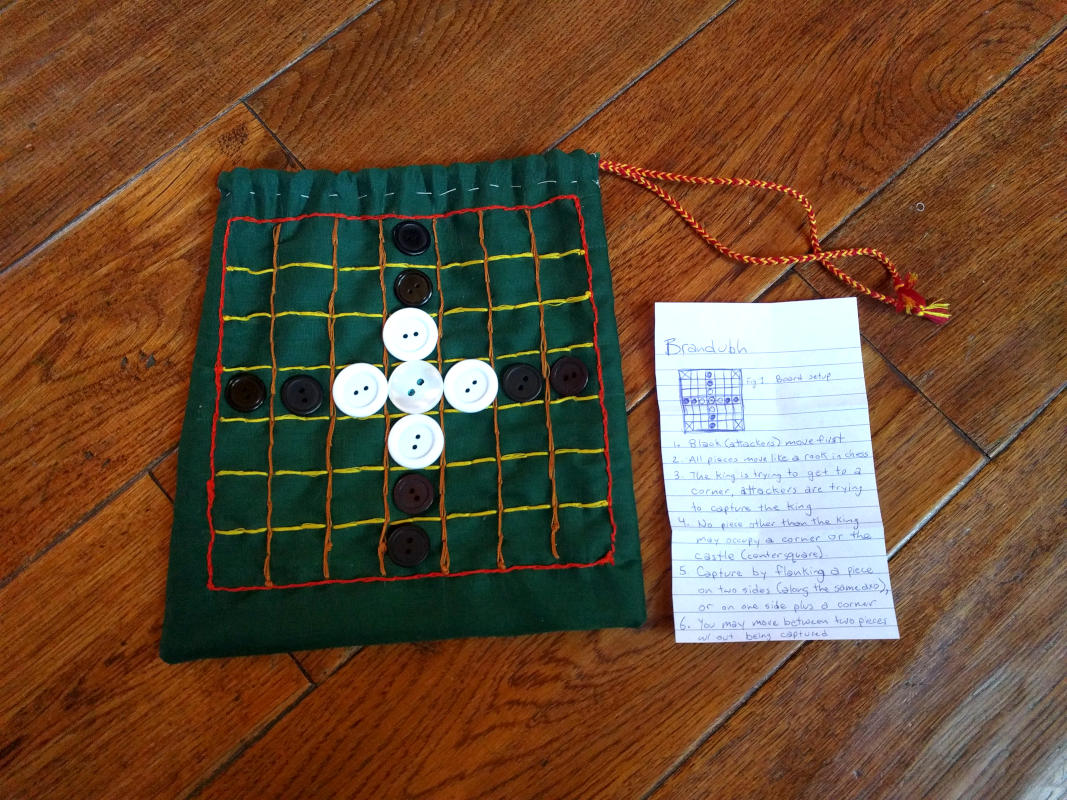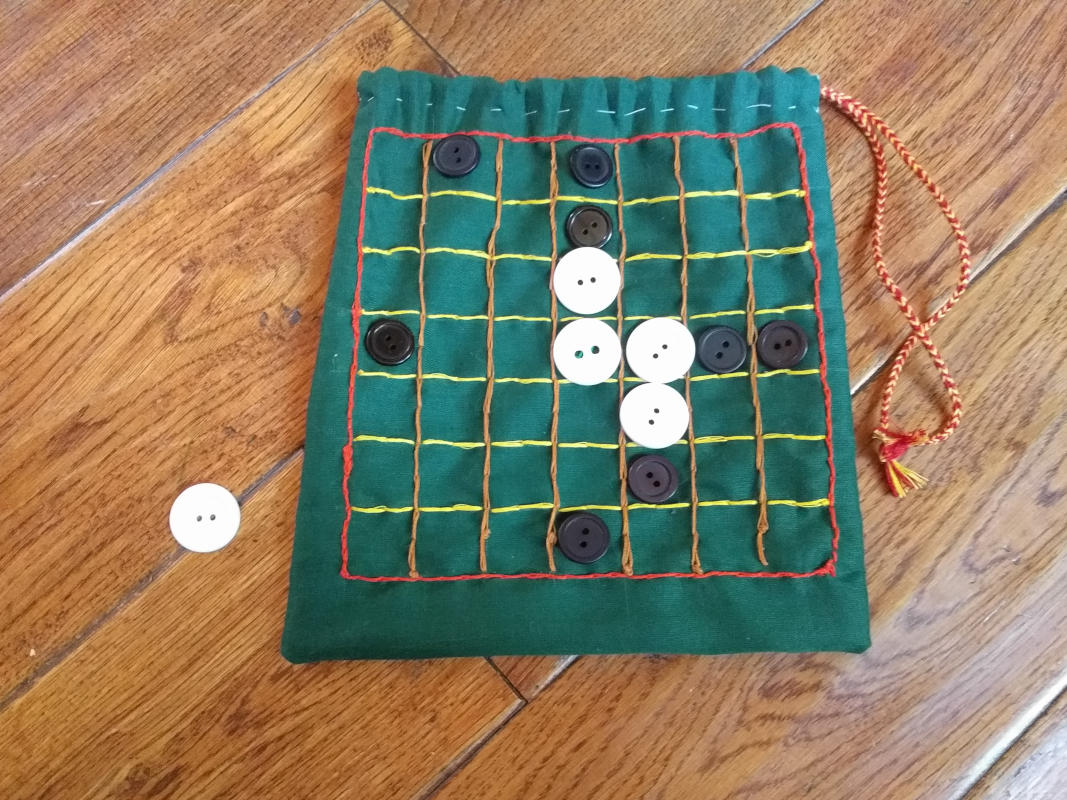fiber arts : sewing : brandubh game
This was a really fun project to work on, though I got a little impatient and took some shortcuts and made wider stitches than would have been preferable. The project is a fairly basic bag/pouch with a draw cord (that I made myself by doing a five loop (ten strand) fingerloop braid with embroidery floss—a project within a project, as is often the case).
Prior to sewing the bag I measured, cut, and marked the grid for a brandubh board out with chalk pencil. I then embroidered the grid over the chalk lines. I used a backstitch (into the previous thread, so almost a chain stitch) for all of the embroidery. The edge of the board is smaller stitches, but the grid squares are 1" and I used 0.5" backstitch for the internal lines. I then embroidered a simple ✕ in the center square. I opted to not mark the corners, as is common for brandubh, as I wanted to leave it open to other games that might not use corner escape.
Once the embroidery was done I cut a second piece of cloth to the same measure as the initial cloth piece and used it as a backing layer. This keeps the inside of the embroidery safer in the bag, while also making for a thicker material that is less translucent (I used cheap cotton fabric I bought as a fat quarter when Joanne craft stores were closing, I think I paid a dollar). I then folded the two in half together with the embroidery facing in (essentially making the bag inside out). I then stitched up the seams on the sides, stopping 1" from the top on one side. I believe I backstitched here too, but with regular thread, rather than embroidery floss. With that done, I folded the top down half an inch and went around toward the bottom of that fold with a running stitch all the way around (in a circle, not through the whole of the bag), this creates the path for the cord.
After making it and using it for awhile, I noticed that some of the seams around the cord pull were coming loose, so I reinforced those area, since the get more stress than the rest. I also noticed fraying at the openings where the cords exit the bag. I have not yet, but plan to, whip stitch around the openings to protect that space a little more (I had initially done a running stitch that has proven insufficient).
I am pretty happy with how it came out, though I had my doubts while crafting it. My daughter and I have played many games on it. We used buttons for the pieces (8 black, four white, and one white with a nacreous sheen to it (for the king/cheiftan/lor/leader/etc). I am also really happy with the fingerloop braid used as the cord. I have made five loop braids of this sort a number of times before and always really like them. I used three red strands, one yellow, and one orange to make the cord.
Images
Information
- Thread Type
- Hand sewing thread, white
- Embroidery floss, red, yellow, gold, cyan
- Other supplies
- Scissors
- Sewing needle(s)
- Cotton fabric
- Buttons, 8 black, 4 white, 1 nacreous white
Notes
Brandubh is an old game with many versions of the rules that have been reconstructed from old poems and manuscripts. Here are the rules I have written down for use when playing the game:
- Board setup: The cheiftan (nacreous white button) occupies the center square with the other white buttons above, below, left, and right (forming a sort of cross). The black buttons extend out from the points of the white cross (two buttons on the two spaces between the white point and the edge of the board). With the board I have designed pieces are placed like in chess or checkers: in the squares. It is also possible to design a board where the pieces are placed like in go: on the intersections (this would actually require less embroidery as it is one row less). Black, the attackers, always go first
- Movement: All pieces move like a rook in chess: they can move any number of spaces in one orthagonal direction (no diagonal movement). They cannot move through/over other pieces.
- Only the chieftan may occupy the fortress (the central square), but other pieces may move through it if it is not occupied
- Only the chieftan may occupy any of the four corners (and doing so ends the game with white winning)
- Object: The player playing white is trying to get their chieftan to a corner of the board. The player playing black is trying to capture the king.
- Capturing:
- Capture occurs by flanking a piece on two sides (left/right or top/bottom, but not, for example top/left)
- When a piece is captured it is removed from the board
- A player may move one of their pieces between two of their opponenents pieces without being captured, the opponenet would then need to move a piece away and back to capture that piece
- It is possible to capture multiple pieces (generally on multiple axis) with one move
- If the chieftan is in his fortress (the central square), he must be surrounded at the four orthagonal points (forming a cross), otherwise, he is captured the same as any other piece
- The corner squares cannot be occupied by any piece other than the king, and are hostile to all pieces (including the king). As such a piece can be captured if it is next to a corner and an enemy piece moves to flank them (with the empty corner acting as on of their pieces)
- If the same moves are repeated over and over without real or meaningful change, the game is considered a draw
- Black (the attackers) can also win by surrounding the chieftan (including any number of empty space and any number of his warriors) in such a way that there is not gap in their formation. It is considred a victory since the chieftan is surrounded and cannot escape
- In some versions of the game the chieftan needs to be surrounded on four sides when in his fortress, that is not the case in this version. In some versions of this style game the chieftan is unarmed and cannot capture, that is not the case in this version. In some version the fortress is hostile (like the corners) to all players when the chieftan is not in it (and to black alone when the chieftan is in it), that is not the case in this version
- It is generally recommended to play multiple games, switching off who plays each side for each game. This results in even matchups. The game, when played by skilled players, is generally deemed to favor the defender (white)
Have fun! We really enjoy playing it. My child grasps it better than Go, and about as well as chess. It is a fun game for us to play when we have some down time. This build of it in a bag makes it easy to travel with so that we can play whenever/wherever the mood striked.


